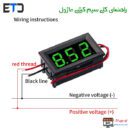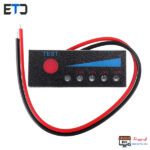نقد و بررسی
- ولتاژ قابل اندازه گیری:2.5 تا 30 ولت دی سی
- بازه ی ایده آی ولتاژ:3.5 تا 29 ولت
- دمای کاری:منفی 10 تا 65 درجه سانتی گراد
- جریان مصرفی کمتر از 20 میلی آمپر
- امپدانس ورودی:بیش از 100 کیلو اهم
- موجود در رنگ های سبز و قرمز و آبی(ارسال رندوم)
ولت متر پنلی 2.5 تا 30 ولت دی سی دیجیتال
این ولت متر برای نمایش ولتاژ در دستگاه های مختلف به کار می رود و قابلیت نصب بر روی پنل را دارد. تغذیه این ماژول از همان ولتاژ مورد اندازه گیری تامین می شود و باید مقداری بین 2.5 الی 30 باشد. دقت اندازه گیری 0.1 ولت می باشد.
در کل دارای دو سیم می باشد،که هم ولتاژ تغذیه و هم ولتاژ ورودی می باشد.در واقع یک ولت متر ایده آل برای زمانی که امکان دادن ولتاژ تغذیه به صورت جداگانه وجود ندارد.

ولت متر پنلی دی سی دیجیتال
I.ولت متر پنلی 2.5 تا 30 ولت دی سی دیجیتال:
معرفی و کاربردها:
A. ورودی و خروجی ولت متر پنلی
B. دقت و قابلیت های ولت متر
C. کاربردهای رایج ولت متر پنلی
II. نحوه استفاده از ولت متر پنلی 2.5 تا 30 ولت دی سی:
A. مراحل نصب و تنظیمات اولیه
B. توضیحات مفصل درباره نمایشگر ولت متر
C. خواندن مقادیر ولتاژ با دقت
III. مزایا و معایب استفاده از ولت متر پنلی دیجیتال
A. مزایای استفاده از ولت متر پنلی دیجیتال
B. معایب ممکن در استفاده از ولت متر پنلی
IV. مراقبت و نگهداری ولت متر پنلی:
A. تمیز کردن ولت متر
B. ذخیره سازی صحیح ولت متر
C. رفع اشکالات کوچک خودکار
ولت متر پنلی دیجیتال یکی از ابزارهای حیاتی در صنعت الکترونیک است که به کنترل و نظارت بر ولتاژهای مختلف کمک میکند. این دستگاه با دقت بالا و قابلیتهای منحصر به فرد خود، در اندازهگیری و نمایش ولتاژهای 2.5 تا 30 ولت دی سی عملکرد میکند.

ولت متر پنلی 2.5 تا 30 ولت دی سی دیجیتال
نحوه استفاده از ولت متر پنلی 2.5 تا 30 ولت دی سی:
برای استفاده از ولت متر پنلی دیجیتال نیاز به مراحل نصب و تنظیمات اولیه داریم. ابتدا دستگاه را به منبع ولتاژ مورد نظر وصل کنید. سپس با استفاده از دکمهها و منوهای موجود در ولت متر، تنظیمات را انجام دهید. نمایشگر دیجیتال ولت متر نتایج را با دقت نشان میدهد که به کاربر اطلاعات دقیق در مورد ولتاژ مورد نظر را ارائه میکند.
مزایای استفاده از ولت متر پنلی دیجیتال:
استفاده از ولت متر پنلی دیجیتال به دلیل دقت بالا و قابلیت خوانایی آسان اطلاعات، امری بسیار مهم است. همچنین، قابلیتهای اضافی این دستگاه مانند حفاظت از ولتاژهای بیش از حد و امکانات نمایشگر، از مزایای بارز استفاده از ولت متر میباشد.
معایب ممکن در استفاده از ولت متر پنلی:
با وجود مزایا، برخی معایب هم وجود دارد. به عنوان مثال، ولت متر پنلی دیجیتال ممکن است در مواقعی که ولتاژها بسیار بالا باشند، دچار خطا شود. همچنین، نیاز به تنظیمات اولیه ممکن است برخی کاربران را دچار مشکل کند.
ویژگی های فنی و مهم ولت متر پنلی 2.5 تا 30 ولت دی سی دیجیتال:
- ولتاژ قابل اندازه گیری:2.5 تا 30 ولت دی سی
- بازه ی ایده آی ولتاژ:3.5 تا 29 ولت
- دمای کاری:منفی 10 تا 65 درجه سانتی گراد
- جریان مصرفی کمتر از 20 میلی آمپر
- امپدانس ورودی:بیش از 100 کیلو اهم
- موجود در رنگ های سبز و قرمز و آبی(ارسال رندوم)
0.36″ 2.5-30 Volt 2 Wire DC Voltmeter – Digital
Feature:
The measurement range of the voltmeter is 0-30V. This voltage is only a measurement signal and cannot be used as the working power supply of the voltmeter.
Therefore, the voltmeter needs to provide 5-30V DC voltage from the outside as the working power supply.
Among the three wires, the black wire is the common negative pole, the white wire is connected to the positive pole of the measurement voltage, the red wire is connected to the positive pole of the working power supply, and the total negative pole in the meter
Measuring range :0V-30V / 0-100V
Two wires =DC30.0V。 Note: Input voltage higher than 30V may be permanently damaged!
Three wires = 0-100V, but can not use a large current, otherwise it will damage the product
Allowable error:±1%; When it is greater than or equal to 10V, the error is ± 0.3V; Error ± 0.10 when less than 10V
Input impedance:>100K Ω
Operating current:Red<23mA, green<18mA, blue<13mA
Refresh Rate :About 300mS once
Display mode:Three digit 0.56 “LED digital tube
Display Color:Red / Green /Blue /Orange /White
Lead Length: 20cm
Overall dimensions:48 x 29 x 22 mm, L x W x T;
Mounting hole:46 x 27 mm
Working Temperature :-10℃~65℃
مدل های مشابه:
- ولت متر آمپر متر دیجیتالی پنلی 100V-10A
- ولت متر پنلی 0 تا 100 ولت قرمز
- ماژول دماسنج دیجیتال پنلی XY-WT01 Temperature Controller
Understanding the DC Voltmeter
Introduction
In the realm of electronics, understanding and measuring voltage is paramount. A crucial tool in this endeavor is the DC voltmeter, often referred to simply as a voltmeter.
But what exactly is a DC voltmeter, and how does it function? In this comprehensive guide, we will delve into its definition, applications, and inner workings to provide you with a thorough understanding of this indispensable electronic instrument.
Definition and Purpose
A **DC voltmeter** is an electronic measuring device designed to measure and display direct current (DC) voltage levels. Unlike its AC (alternating current) counterpart, which measures the fluctuating voltage of alternating current, a DC voltmeter is tailored specifically for the stable, unidirectional flow of current in electronic circuits.
### How Does a DC Voltmeter Work?
At its core, a DC voltmeter operates on the principle of the voltmeter movement—a sensitive electromagnetic mechanism.
When voltage is applied to the voltmeter, it causes a current to flow through a coil, generating a magnetic field. This field interacts with a permanent magnet, resulting in a rotational force that moves a pointer across a calibrated scale, indicating the measured voltage.
## Applications of DC Voltmeters
DC voltmeters find widespread use across various industries and applications due to their precision and reliability. Some common applications include:
1. **Electronics Testing**: Assessing the voltage levels in electronic circuits to ensure proper functioning.
2. **Power Supply Monitoring**: Verifying the output voltage of power supplies to guarantee stable and consistent power delivery.
3. **Battery Testing**: Checking the voltage of batteries to determine their charge status and overall health.
4. **Automotive Diagnostics**: Troubleshooting electrical systems in vehicles by measuring voltage levels.
5. **Industrial Automation**: Monitoring voltage in automated processes to prevent electrical failures.
## Advantages of Using DC Voltmeters
### Accuracy and Precision
DC voltmeters are known for their high degree of accuracy in measuring voltage levels. This precision is crucial in critical applications where even a slight deviation from the specified voltage can lead to malfunctions or damage.
### Ease of Use
With clear and intuitive displays, DC voltmeters are user-friendly even for those with limited technical expertise. The straightforward readouts make them accessible tools for both professionals and hobbyists.
### Overvoltage Protection
Many modern DC voltmeters come equipped with over voltage protection mechanisms. These safeguards prevent damage to the voltmeter in cases of excessive voltage, ensuring its longevity and reliability.
To ensure the longevity and accuracy of your DC voltmeter, consider the following maintenance tips:
1. **Keep it Clean**: Regularly wipe the voltmeter with a clean, dry cloth to remove dust and debris.
2. **Store Properly**: When not in use, store the voltmeter in a cool, dry place away from direct sunlight or extreme temperatures.
3. **Calibration Check**: Periodically verify the accuracy of your voltmeter using a known voltage source or a calibration device.
Frequently Asked Questions
### How does a DC voltmeter differ from an AC voltmeter?
DC voltmeters are designed specifically for measuring direct current, which flows in one direction. AC voltmeters, on the other hand, are tailored for alternating current, which changes direction periodically.
### Can I use a DC voltmeter to measure AC voltage?
While a DC voltmeter can physically measure AC voltage, it will provide inaccurate readings due to its design optimized for DC. It’s recommended to use an AC voltmeter for accurate AC voltage measurements.
### What is the typical accuracy of a DC voltmeter?
Most high-quality DC voltmeters have an accuracy of around ±0.5% to ±2%, ensuring reliable measurements in various applications.
### Are digital or analog DC voltmeters better?
Digital voltmeters offer precise numeric readouts, making them suitable for highly accurate measurements. Analog voltmeters, however, provide a visual representation of voltage trends, which can be useful for dynamic readings.
### Can a DC voltmeter be used on high-voltage circuits?
It’s essential to select a DC voltmeter with an appropriate voltage range that matches the circuit you intend to measure. Using a voltmeter with insufficient range can lead to inaccurate readings and potential damage to the voltmeter.
Conclusion
In conclusion, a DC voltmeter is an indispensable tool in the world of electronics, allowing precise measurement of direct current voltage levels. Its accuracy, ease of use, and versatility make it a vital instrument for professionals and enthusiasts alike. By understanding its inner workings and applications, you can harness the full potential of this essential electronic measuring device.













0دیدگاه